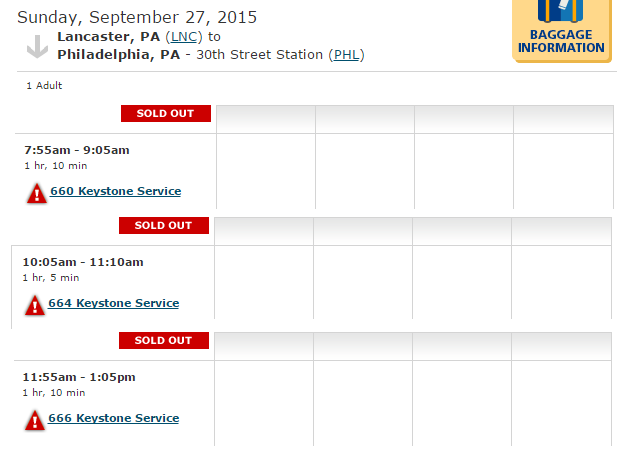The June 2015 Monthly Performance Report has been posted (64 page PDF). It is not a positive report. System wide, ridership and revenue was down from June 2014. Net operating loss for the month and Year To Date missed the budget targets. Ridership was up for the NE Regionals and Acelas, but down overall for the state supported corridor and LD trains.
The report blames “Low gasoline prices, trackwork projects, and weather-related cancelations adversely affected June's performance.” Low gasoline prices may be a part of the issue for the state corridor services, but I think the dropoff in ridership is due more to the corrosive effects of poor On-Time Performance. Which in turn is due to trackwork projects and weather related cancellations, but equipment problems & locomotive breakdowns, track & signal problems, slow orders, freight traffic congestion, grade crossing incidents, overly long station dwells are also contributing to the lousy OTP. Will help when real progress can be seen on some of the long running track upgrade projects especially the CHI-STL corridor, but the HSIPR funded projects work on many corridors just drags on for another construction season. At least, the Downeaster should begin to get back to normal in August.
System financial results: In June, the adjusted operating loss for the month was $16.6 million and for the Year-To-Date (YTD) was $228.0 million. The good news is Fuel, Power, & Utilities expense category is running well under budget thanks to the drop in oil prices ($63.3M under budget and $54.8M less than last year for YTD).
Ridership and Ticket Revenue
High level look at the ridership and revenue numbers. The NEC shows its resiliency by growing in ridership after the #188 derailment in May. The Downeaster ridership was down -53.3% in June because of the many cancellations and bustitutions during the Pan Am track work blitz. Having poor to bad months for ridership were the Illinois services with the Lincoln service off -13.1%, Wolverine (-7.0%), Hoosier State, Heartland Flyer (-22.8% due to floods), WAS-NPN, WAS-NFK, WAS-LYH, Carolinian (-15.0%), Piedmont (-16.3%). The good news for the state corridors were ridership increases for the Vermonter, NYP-ALB, Surfliner, Capitol Corridor.
For the LD trains, the AutoTrain had a -5.3% decline in June for ridership which I expect will be of interest. The EB June ridership was up +10.4%, but that is in comparison to June 2014. The Silver Star continues to struggle with a -10.9% June ridership decline. This, it should be noted, was before the experiment to drop the dining car which started at the beginning of July.
Ridership and Revenue summary for the month of June:
System: ridership -0.5%, revenue: -1.2%
Acela: ridership +2.7%, revenue: +2.9%
NE Regional: ridership +1.8%, revenue -0.2%
State supported corridors: ridership -2.2%, revenue -3.0%
LD trains: ridership -1.1%, revenue -5.2%
Ridership and Revenue summary for the YTD from October to June:
System: ridership +0.4%, revenue: +0.6%
Acela: ridership -1.8%, revenue: +0.7%
NE Regional: ridership +2.8%, revenue +1.7%
State supported corridors: ridership +0.5%, revenue +1.2%
LD trains: ridership -2.0%, revenue -1.5%
The report blames “Low gasoline prices, trackwork projects, and weather-related cancelations adversely affected June's performance.” Low gasoline prices may be a part of the issue for the state corridor services, but I think the dropoff in ridership is due more to the corrosive effects of poor On-Time Performance. Which in turn is due to trackwork projects and weather related cancellations, but equipment problems & locomotive breakdowns, track & signal problems, slow orders, freight traffic congestion, grade crossing incidents, overly long station dwells are also contributing to the lousy OTP. Will help when real progress can be seen on some of the long running track upgrade projects especially the CHI-STL corridor, but the HSIPR funded projects work on many corridors just drags on for another construction season. At least, the Downeaster should begin to get back to normal in August.
System financial results: In June, the adjusted operating loss for the month was $16.6 million and for the Year-To-Date (YTD) was $228.0 million. The good news is Fuel, Power, & Utilities expense category is running well under budget thanks to the drop in oil prices ($63.3M under budget and $54.8M less than last year for YTD).
Ridership and Ticket Revenue
High level look at the ridership and revenue numbers. The NEC shows its resiliency by growing in ridership after the #188 derailment in May. The Downeaster ridership was down -53.3% in June because of the many cancellations and bustitutions during the Pan Am track work blitz. Having poor to bad months for ridership were the Illinois services with the Lincoln service off -13.1%, Wolverine (-7.0%), Hoosier State, Heartland Flyer (-22.8% due to floods), WAS-NPN, WAS-NFK, WAS-LYH, Carolinian (-15.0%), Piedmont (-16.3%). The good news for the state corridors were ridership increases for the Vermonter, NYP-ALB, Surfliner, Capitol Corridor.
For the LD trains, the AutoTrain had a -5.3% decline in June for ridership which I expect will be of interest. The EB June ridership was up +10.4%, but that is in comparison to June 2014. The Silver Star continues to struggle with a -10.9% June ridership decline. This, it should be noted, was before the experiment to drop the dining car which started at the beginning of July.
Ridership and Revenue summary for the month of June:
System: ridership -0.5%, revenue: -1.2%
Acela: ridership +2.7%, revenue: +2.9%
NE Regional: ridership +1.8%, revenue -0.2%
State supported corridors: ridership -2.2%, revenue -3.0%
LD trains: ridership -1.1%, revenue -5.2%
Ridership and Revenue summary for the YTD from October to June:
System: ridership +0.4%, revenue: +0.6%
Acela: ridership -1.8%, revenue: +0.7%
NE Regional: ridership +2.8%, revenue +1.7%
State supported corridors: ridership +0.5%, revenue +1.2%
LD trains: ridership -2.0%, revenue -1.5%




